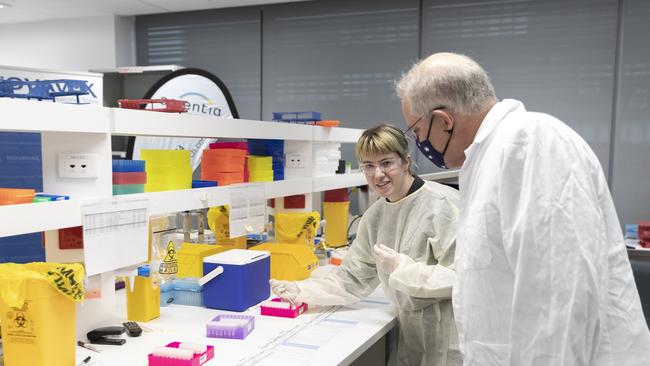Coronavirus vaccine: PM backs a needle in a haystack
Scott Morrison exercises an iron hand over his ministers and mandarins, so when public chatter went off the rails, the big boss thumped the table.

When Scott Morrison returned to work from leave last month, he put a rocket up the top echelon of Canberra’s public service. The Prime Minister was livid about aspects of the COVID-19 vaccines strategy and marketing, as public chatter went feral over why Australians weren’t being vaccinated.
Voters recalled being told by Morrison over the latter months of last year that Australians were “at the front of the queue” for vaccines. So how come authorities were taking so long to grant approvals given inoculation programs were under way in the US, Britain and Europe? Did Australia order enough of the leading Pfizer/BioNtech candidate?
The Prime Minister shifted the vaccines sales pitch earlier in the summer, emphasising our enviable position in containing the spread of coronavirus, high regulatory safety standards and sound rollout game plan. We could afford to watch and wait. But once vaccine envy crept up here in the New Year, the big boss thumped the table and the capital’s bureaucratic elite responded.
Morrison exercises an iron hand over ministers and mandarins, as well as government messaging, especially on core business: the economy, health, and China. Vaccines are fundamental for the first two items, perhaps even a precursor to dealing with the fallout from the third.
New infections arising from hotel quarantine in Western Australia and Victoria show how tenuous the path back to reopening will be in some states until the vaccine rollout, which begins in a matter of weeks, gathers pace.
Also fragile is public confidence. Newspoll shows three-quarters of Australians plan to take the COVID jab. So-called hesitancy may be relatively low compared with other nations, but the 25 per cent who say they will refuse or are undecided is a significant rump of sceptics. This week Morrison brought to heel his vaxx refusenik MP, Craig Kelly, after the optics hurt the government on several levels.

If last year the soothing mantra was saving lives and livelihoods via fiscal inundation, the coming one is centred on the $6.3bn vaccine program and its rollout. It’s jabs, jabs, jabs. For the time-poor, Morrison’s elevator pitch is: “Vaccination will mean that Australians will be able to start enjoying more freedoms.”
The Prime Minister maintains we are on track to vaccinate by October all those who volunteer; the free program is being extended to all visa holders, including refugees and asylum seekers, to attain maximum possible coverage.
The rollout is as much about massaging community psychology as it is about saving lives in a nation that has been willing to make sacrifices on liberty, pay a high economic price and run up a vast debt to snuff out community transmission of the virus. It is a confidence builder for consumers to spend and businesses to invest, and the survey data on this score is soaring to record highs.
The vaccine is the key to keeping state borders open, limiting lockdowns and reducing the number of fatalities, which have been mercifully low outside aged care and among those with compromised health.
The vaccine rollout should give Western Australia’s Premier, Mark McGowan, more courage to keep his isolated state connected. Certainly, Queensland’s hi-vis mendicant, Annastacia Palaszczuk, will have even less cover for border lollipop swivels of her stop-go sign to visitors.
With federal government spending at $671bn this financial year, or one-third of gross domestic product, the outlay on vaccines (here and to meet our international obligations) is tiny given the potential shot of dynamism to the economy, or the protection of lives. No one is talking about “value for money” in this space, although that day will come.
At the National Press Club on Wednesday, Reserve Bank governor Philip Lowe naturally put the path of the pandemic, and how authorities react to outbreaks, at the centre of the outlook for our recovery. “The development of vaccines in record time is clearly good news,” Lowe said. “It has reduced one of the big uncertainties and could provide the foundation for a vigorous and sustainable recovery in the global economy.
“But this outcome is not assured — the global rollout of the vaccines faces challenges and there are a range of other uncertainties about the global economy, including trade tensions. We hope for the best here, but we also need to be prepared for further setbacks in what remains a highly uncertain world.”

In an update to its World Economic Outlook last month, the International Monetary Fund said ongoing fiscal support in large economies and a “vaccine-powered strengthening of activity” would lift global growth to 5.5 per cent this year, after a 3.5 per cent slump last year.
On Friday, the RBA released updated forecasts in its quarterly Statement of Monetary Policy. Its economists assumed a rollout of the vaccines in Australia in line with current government guidance and that international travel remains highly restricted for the rest of this year.
GDP is forecast to rise by 3.5 per cent this year and next, with national output returning to its pre-pandemic level by mid-year, as much as 12 months earlier than the RBA previously expected. Private sector watchers are even more bullish, with Commonwealth Bank economists expecting a V-shaped recovery and growth of 4.2 per cent this year.
CBA’s Gareth Aird says the performance of the COVID economy gives the impression the machine has been under the influence of a remote control. “The play, pause, slow motion and fast forward buttons have all featured,” he writes in a note to clients. Some air pockets may occur in the data if virus clusters emerge and restrictions are imposed.
“But we don’t expect the economic recovery to be derailed, particularly given that the COVID-19 vaccine rollout in Australia is due to begin shortly,” Aird said. “Indeed, the domestic economy could be booming in the second half of the year if the vaccination schedule is successful and the economy has clear air.”
“Vaccines are game-changers,” says Deloitte Access Economics partner Chris Richardson, who jests to Inquirer that he finds himself in the unusual position of being optimistic, which goes against the grain for an economist. “The bottom line is that the economic news continues to be excellent in Australia, and better than expected in a number of nations.”
In Deloitte’s recent Business Outlook, Richardson noted lockdowns and border closures had “smashed” airlines, accommodation, food, tourism operators, retail, education providers and the entertainment industry. “Opening back up creates a big bounce. Business conditions AV (after vaccines) will look very different to those BV (before vaccines).”
And by next year, tourists and foreign students will be here in greater numbers. The pause to Big Australia may be shorter than many population-dependent industries, such as construction and retail (and tax collectors), had feared and a growing number in the community had welcomed.
For Richardson, one of the pandemic’s silver linings is it reminds us new technologies can make an enormous difference. “Productivity growth has been falling — globally and locally — for many years. That has economists worried. In effect, productivity tells us what will happen to future living standards, so a lack of progress on one foretells a lack of progress on the other.

“Yet the warp speed with which vaccines have been developed is a reminder that productivity positivity is a growing possibility. Some of these new vaccine technologies could, for example, be harnessed to develop a related vaccine for the common cold. That would be … neat.”
Vaccine rollout is also a scorecard of system competence and political management. In Morrison’s NPC speech on Monday, the vaccine strategy was the ballast in a listing exercise where every portfolio got a nod, if not a prize. Vaccine logistics apparently got a $1.9bn injection, but it looked suspiciously like the Christmas Eve announcement on new distribution and data contracts by Health Minister Greg Hunt.
This realm of spending is a box of secrets, with numbers shifting amid the constant refrain of “commercial in confidence” when questions are raised about the value and conditions of vaccine deals, subsidies for manufacture and scoping studies for new factory capacity. So there’s fumbling in the dark for proper information disclosure, even among bureaucrats.
Last week in testimony to the Senate’s COVID-19 committee, a senior Health official provided details on value and doses for CSL’s deals to manufacture vaccines that were seven weeks out of date; the game had changed after the University of Queensland’s “molecular clamp” development was abandoned, and the government was forced to buy more doses from AstraZeneca and Novavax.
Health officials are under the pump, for sure, facing supply delays beyond their control as Europe bans exports. Plus there’s political heat at every step, with the government also on edge. Morrison and his office are not so much micro managers as macro managers.
A source familiar with vaccine policy told Inquirer the Prime Minster’s Office wants to be in control of the entire “campaign”, which has military, marketing and political overtones beyond the medical nuts and bolts.
The government’s “Vaccine and Treatment Strategy” document, released this week through the Health Department’s website, may look like a health road map but it is the work of Team Australia spin doctors rather than medicos.
“Going into 2021, Australians are among the most fortunate people on Earth. 2020 was a tough year, but we came out of it the envy of the world. Together, we fought COVID-19 and, while the battle is far from over, we’re ready for the challenges ahead,” the document begins.
It lauds our sacrifices, wills us to keep up the fight, claims Australia “moved early to ensure that when a vaccine became available, Australians would be able to receive it as soon as possible after it was proven safe”. The pitch even talks up the government’s jobs strategy and good global citizenship in a world where vaccine nationalism reigns.
After the Therapeutic Goods Administration granted provisional approval on January 25 to Pfizer for its vaccine candidate, COMIRNATY, Morrison got a mood boost ahead of Australia Day but wanted to keep expectations in check. “Of itself, it is not a silver bullet because there are still limitations to what these vaccines can do. It is important to understand that once the vaccines start, that doesn’t mean you can jump on a plane to Bali the next day.”
It may not be a silver bullet, but Canberra has just bought another 10 million doses from Pfizer, doubling our supply deal of its mRNA vaccine, and taking total doses to 150 million across four purchase agreements. Aside from vaccine hoarder Canada, Australia is in the elite pool of rich nations that have six vaccine doses per person. Some of that supply is stuck in Europe; the vaccine most of us will receive and that will be produced here, the AstraZeneca, is yet to receive TGA approval.
On Friday, Morrison briefed national cabinet on the rollout and announced that his departmental chief Phil Gaetjens will head a group to advise on the changed “risk matrix” in light of new variants of the virus and the impact of vaccines. Morrison said the goal was to “manage the virus like other conditions that are in the community”.
That shift would put a rocket under the recovery.





